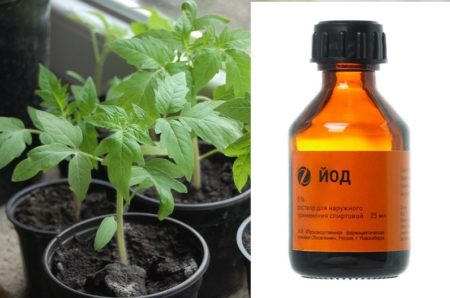
Iodine is an extremely useful substance not only in medicine, but also in the cultivation of various crops. The fact is that iodine is one of the essential trace elements of vegetable crops, including pepper and tomatoes. Today we’ll talk about how to recognize the need of plants for iodine and how to make up for the deficiency of this nutrient when growing seedlings of vegetables.
Content
What is the use of iodine for seedlings
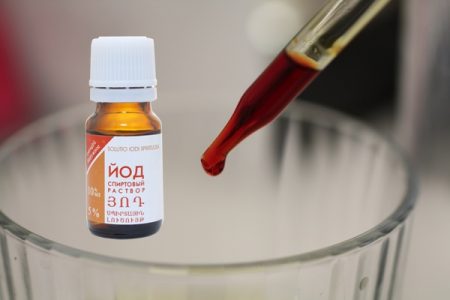
Tomatoes and peppers make rather high demands on the iodine content in the soil and, with its deficiency, are not able to fully grow and develop. Along with other nutrients, iodine is involved in the most important biological processes in plants.
A sufficient amount of iodine is found in chernozem and chestnut soils. But sierozem, solonchak and podzolic soils almost do not contain iodine. A small iodine content is found in mineral and organic fertilizers such as phosphate rock, wood ash and manure.
Iodine belongs to the group of microelements of plant nutrition, which means that for the vital functions of pepper or tomatoes it requires very little, in comparison, for example, with nitrogen. Mineral fertilizers containing iodine are not available. But the feed solution with iodine is easy to prepare on your own.
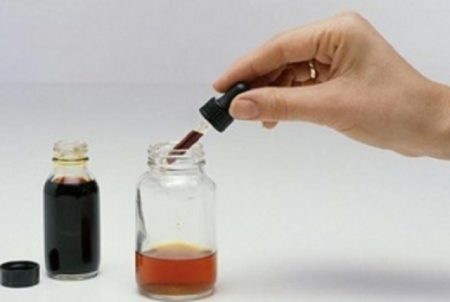
Iodine top dressing has the following advantages:
- seed-seed treated with iodine gives friendly shoots;
- iodine solution destroys fungal infections, both during the soaking of seed material, and in subsequent phases of plant life;
- the drug increases the defenses of plants to withstand adverse growing conditions;
- the number of flowers and ovaries increases, which has a beneficial effect on the crop;
- Tomatoes and peppers begin to show greater resistance against harmful insects.
Depending on the cultivated crop, its developmental phase and purpose of processing, different concentrations of the feed solution may be used. In the arsenal, any grower should have 2 or more recipes for this type of nutrition. We will talk about popular recipes later.
How to determine that plants are in dire need of iodine
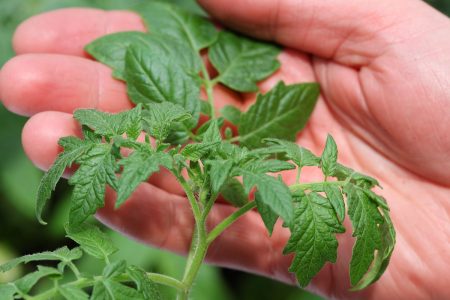
Lack of iodine can cause seedlings of pepper and tomato to serious diseases such as root rot, late blight, and olive spotting.
The fact that plant organisms lack iodine is indicated by the following symptoms:
- stems are too thin and extended;
- the leaves become pale;
- seedlings look unviable and may die;
- adult plants later bear fruiting after usual;
- the fruits are smaller and the overall yield is falling.
If the seedlings are too pale in color, then the first top dressing is done with an iodine-based topical compound. After 8 days, inspect the seedlings. If they do not become more green - carry out the following feeding with urea. The interval between two fertilizer applications is maintained for 10 or more days.
Feeding methods
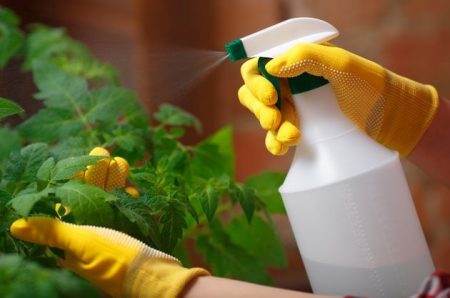
Vegetable growers apply 2 main methods of feeding: root and spraying on the leaves. In the first method, the nutritional composition is poured under the root of the plants.The second method involves applying a nutritional composition to the leaves and stems of plant organisms. To achieve maximum effect, you should alternate these two methods of fertilizing.
As an optional feeding method, seed soaking before planting in a nutrient solution can be considered. This technique allows you to protect plant sprouts at an early stage from pathogens of fungal and bacterial diseases and provide nutrition to a certain element.
Stages of feeding on pepper and tomato seedlings
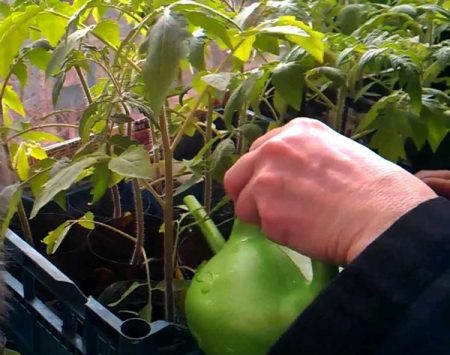
Peppers and tomatoes are the closest relatives and belong to the same family - nightshade. The same feeding pattern is practiced on these crops, the essence of which is as follows:
- spend six hours soaking the seeds on the eve of sowing in a liquid solution consisting of 3 drops of iodine and 3 l of water;
- introduction under the root in phase 2 of this leaf nutritional composition, consisting of 1 drop of iodine and 3 l of water;
- root application, during the formation of the first brush, an infusion of ash mixed with boric acid and iodine;
- spraying on the leaves with a composition consisting of milk and iodine from fungal diseases.
Recipes of feed solutions using iodine
Over many years of growing tomato and pepper seedlings, many recipes for iodine-based feed solutions have been invented and tested in practice.
Recipe with iodine, serum and hydrogen peroxide
The recipe for protecting seedlings from late blight is quite popular:
- 40 drops of iodine diluted in 1 liter of serum;
- add to the composition of 1 tbsp. hydrogen peroxide;
- mix well;
- carry out spraying.
Recipe using milk and iodine
To create a feed solution, perform the steps according to the following algorithm:
- take 4 liters. water;
- pour 1 liter into the bucket. fresh cow's milk;
- add 15 drops of iodine;
- mix and apply for spraying.
This top dressing has established itself as a good fungicidal agent. Thanks to milk, the surface of the leaves is covered with a protective film, which prevents the pathogens from fixing on them.
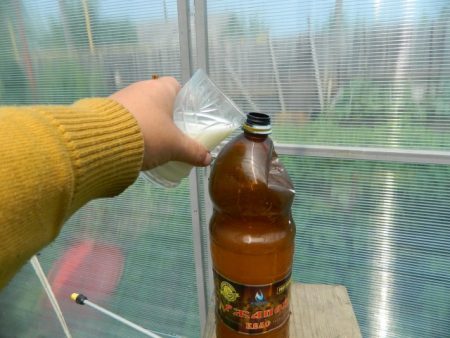
Serum and Iodine Recipe
To prepare, you will need:
- take 10 liters. water;
- add there 1l. serum;
- drip 40 drops of iodine;
- add 10 ml of 3% hydrogen peroxide.
The tool showed a good result against late blight on tomatoes.
Yeast and Boric Acid Recipe
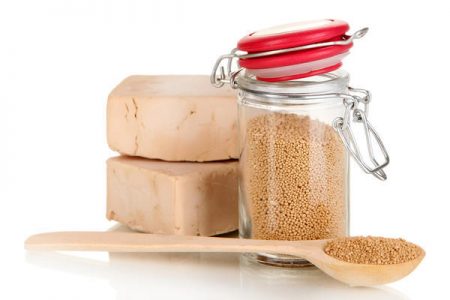
The tool is prepared according to the following algorithm:
- take 1 liter of warm milk or whey;
- dilute 100 g of yeast in a liquid;
- insist 6 hours;
- add water to the solution, bringing its volume to 10 l;
- add 30 drops of iodine;
- to stir thoroughly.
Such a solution is sprayed with bushes of tomatoes and peppers twice a season: on the eve of flowering and before fruiting. Yeast dressing enriches the plant with microelements and well protects against late blight disease.
Recipe based on iodine and green stuff
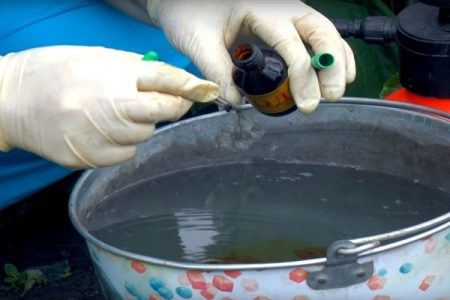
To prepare it, do the following:
- take a bucket of clean water;
- add 10 ml of iodine there;
- drip in the composition of 40 drops of green stuff;
- mix the composition.
The resulting composition is considered a good antiseptic that can be practiced for foliar and root dressing.
Recipe based on iodine and mineral fertilizers
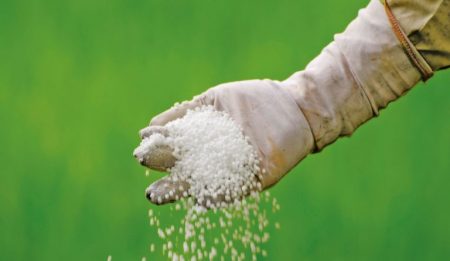
This composition not only nourishes the plants well, but also protects them from fungal diseases. It is prepared like this:
- take a bucket of water;
- add 10 ml of iodine to it;
- add another 10 g of superphosphate and 20 g of potassium sulfate;
- mix until all ingredients are completely dissolved.
With the prepared solution, you can carry out root dressing of plants every 2 weeks at the rate of 500 ml per bush.
The yield of pepper and tomatoes is more dependent on the correct technology for growing seedlings. In order to grow a decent crop of quality vegetables, you need to feed the plants with the necessary nutrients, including iodine. This element is necessary for plants from the time of germination to the end of the growing season. Strong and viable seedlings are the key to an excellent harvest.




 Low-growing tomatoes, without pinching: 5 of the most delicious varieties
Low-growing tomatoes, without pinching: 5 of the most delicious varieties Why tomato seedlings grow poorly
Why tomato seedlings grow poorly We grow a tomato in a shell
We grow a tomato in a shell Growing tomatoes without watering according to the method of Kazarin
Growing tomatoes without watering according to the method of Kazarin